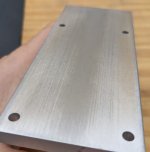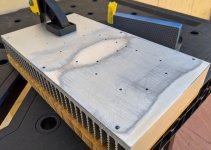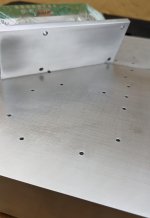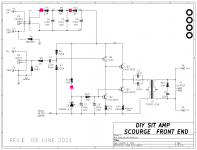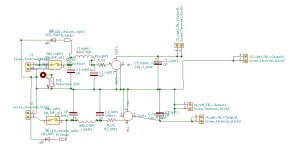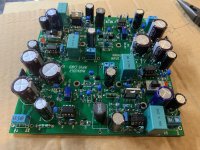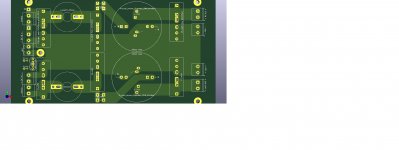Hello all
The kit for my no.25 arrived some weeks ago. Mine was one of the ones that went missing with DHL eCommerce, hopefully by now returned to diyaudio. Thank you Jason for sending me a replacement.
The bonus is the kit was sent from Nelson himself, so I now have a shipping label from Nelson, a nice memorabilia worthy of a frame.
Thank you Nelson.
I have been busy and not had the great peace of mind required to start this build until now.
Upon inspecting the heatsink I realized that some sanding was required. This is definately a keeper, so I want the best possible heat transfer between the bracket and heat sink. I've finished one side and now waiting for some more elbow grease so I can do the other.
See pictures of before and after.
The kit for my no.25 arrived some weeks ago. Mine was one of the ones that went missing with DHL eCommerce, hopefully by now returned to diyaudio. Thank you Jason for sending me a replacement.
The bonus is the kit was sent from Nelson himself, so I now have a shipping label from Nelson, a nice memorabilia worthy of a frame.
Thank you Nelson.
I have been busy and not had the great peace of mind required to start this build until now.
Upon inspecting the heatsink I realized that some sanding was required. This is definately a keeper, so I want the best possible heat transfer between the bracket and heat sink. I've finished one side and now waiting for some more elbow grease so I can do the other.
See pictures of before and after.
Attachments
hello
Yes, it did and I will use it, but I want to have as thin a layer as possible.
On the picture of the sink you can se that there was a "valley" where the bracket is going, I wanted to reduce this.
Yes, it did and I will use it, but I want to have as thin a layer as possible.
On the picture of the sink you can se that there was a "valley" where the bracket is going, I wanted to reduce this.
My Scourge FE cards are running in nicely so far. I built them close to stock; after all the full kit came from the store. I do reserve the creative license to do a bit of capacitor substitution. Mainly a polycarbonate 1.0 uF for input coupling C1, and a blend of Nichicon ES + Wima polypropylene at C2 + C3. Just for entertainment purposes.
At this point the boards are just starting to sound lively, but haven't quite reached the level of full transparency that I've heard from my Bulwark variations. Soundstage presentation is more laid back, but still nicely 3D. Foot-tapping quality is already there, so I am optimistic that these will continue to improve.
At this point the boards are just starting to sound lively, but haven't quite reached the level of full transparency that I've heard from my Bulwark variations. Soundstage presentation is more laid back, but still nicely 3D. Foot-tapping quality is already there, so I am optimistic that these will continue to improve.
Scourge
… and they have arrived!
Reached a well run-in sound, that is. I sat down earlier this morning for a listening session, and found myself completely absorbed by the music; to the extent that I was completely distracted from doing a little on-line research. This was a happy thing.
The music has a wonderful flow, with all harmonic content in place. Rather than occasionally skipping a track, as I sometimes do, I just wanted to listen to each piece. When this happens, I know that I’m done tweaking a new build.
The Scourge FE cards remain somewhat less forward than the Bulwark, but their smooth engaging character is worth the build.
… and they have arrived!
Reached a well run-in sound, that is. I sat down earlier this morning for a listening session, and found myself completely absorbed by the music; to the extent that I was completely distracted from doing a little on-line research. This was a happy thing.
The music has a wonderful flow, with all harmonic content in place. Rather than occasionally skipping a track, as I sometimes do, I just wanted to listen to each piece. When this happens, I know that I’m done tweaking a new build.
The Scourge FE cards remain somewhat less forward than the Bulwark, but their smooth engaging character is worth the build.
… and they have arrived!
Reached a well run-in sound, that is. I sat down earlier this morning for a listening session, and found myself completely absorbed by the music; to the extent that I was completely distracted from doing a little on-line research. This was a happy thing.
The music has a wonderful flow, with all harmonic content in place. Rather than occasionally skipping a track, as I sometimes do, I just wanted to listen to each piece. When this happens, I know that I’m done tweaking a new build.
The Scourge FE cards remain somewhat less forward than the Bulwark, but their smooth engaging character is worth the build.
This sounds absolutely fantastic. Thank you for sharing.
So your opinion is that the Scourge improves on the stock FE cards?
Your report actually inspired me to order a Scourge kit!
It wouldn't surprise me at all, to learn that a few builders have experimented with adding ferrite beads to Scourge in various places. ESPECIALLY owners of the N-channel VFET kit whose SMPS filter board includes resistors and capacitors but no inductors.
There are zillions of beads to choose from; experimenters probably want to select something resembling this bead from Laird, since it has a really large impedance across the anticipated frequency range (~50 kHz to ~400 kHz) of SMPS output noise. Increase the magnification in your pdf viewer so you can read the color XY graph very clearly.
_
There are zillions of beads to choose from; experimenters probably want to select something resembling this bead from Laird, since it has a really large impedance across the anticipated frequency range (~50 kHz to ~400 kHz) of SMPS output noise. Increase the magnification in your pdf viewer so you can read the color XY graph very clearly.
_
Attachments
Last edited:
Bearing in mind that I’m using an external linear power supply, I find that the Scourge FE cards offer a different character than the stock FE. I like the sound. I also love the sound of my Aleph J, a single-ended class A design. Scourge is a single-ended class A circuit, and I think the smoothness of its sound may be due to this, at least in part. There seems to be a synergy with the Scourge & VFET combination.
VFET amp builders with the kit SMPS brick will get more benefits from the extra power filtration on the Scourge. I have mentioned this with each of the newer FE card sets that I’ve built. Mark J makes a good point above with improving the the PSRR even further by adding ferrite beads - a measure that will assist those with the N-channel version of this amp.
VFET amp builders with the kit SMPS brick will get more benefits from the extra power filtration on the Scourge. I have mentioned this with each of the newer FE card sets that I’ve built. Mark J makes a good point above with improving the the PSRR even further by adding ferrite beads - a measure that will assist those with the N-channel version of this amp.
I have experimented adding an additional 2x4700uF (jensen 4-pole) after the stock PS filter in both separate Left & Right Caps and a C-0.1Ω-C config. No issues with the SMPS. To make a cleaner version from my perf-board trials I sketched out the following in Ki-Cad.
Separate channel CLCRCC. Can be configured single or dual SMPS. Could also be configured as CLCRCC-CC by taking the output from right channel and inputing it to the left channel (removing the left side R)
I was wondering if the first C (0.33uF) was optimized for this SMPS or was chosen for convenience. Same with the L value (120uH)
Separate channel CLCRCC. Can be configured single or dual SMPS. Could also be configured as CLCRCC-CC by taking the output from right channel and inputing it to the left channel (removing the left side R)
I was wondering if the first C (0.33uF) was optimized for this SMPS or was chosen for convenience. Same with the L value (120uH)
Attachments
My educated guess is that the first C was chosen to be 0.33 uF in part for convenience, and because it is sufficient. Similar to the use of that value in the output stage.
It's necessary to include the parasitic resistance and inductance of the capacitors {where they go by the names "ESR" and "ESL" respectively}, and also the parasitic resistance and capacitance of the inductors. Otherwise you're asking the simulator the wrong question and of course it happily replies with the wrong answer.
Marauder: High V Opamp
I have been listening to the Marauder FE cards for a couple days already. After some modest capacitor rolling, these have been built very close to the stock kit form. I still prefer Wima polypropylene for the small pF caps (47p & 68p). The 2.2 uF polypropylene caps in the main signal path also seem to be a good synergistic mix with the opamp architecture.
I would describe the sound as fast and detailed. Bass extension and articulation is excellent as well. This is the first opamp based FE that I’ve been able spend more time with. I briefly tried the Tucson FE in my M2x, but quickly replaced it with the Mountain View, which I preferred. TI has done a great job with the opa552. I can recommend the Marauder cards to those who want to hear what a VFET amp sounds like without the Edcor iron in the signal path.
I have been listening to the Marauder FE cards for a couple days already. After some modest capacitor rolling, these have been built very close to the stock kit form. I still prefer Wima polypropylene for the small pF caps (47p & 68p). The 2.2 uF polypropylene caps in the main signal path also seem to be a good synergistic mix with the opamp architecture.
I would describe the sound as fast and detailed. Bass extension and articulation is excellent as well. This is the first opamp based FE that I’ve been able spend more time with. I briefly tried the Tucson FE in my M2x, but quickly replaced it with the Mountain View, which I preferred. TI has done a great job with the opa552. I can recommend the Marauder cards to those who want to hear what a VFET amp sounds like without the Edcor iron in the signal path.
Beautiful work @rhthatcher! Congratulations.
I'm very glad to see that the Store kit includes those teal blue Kemet polypropylene film capacitors; they are excellent parts.
I'm very glad to see that the Store kit includes those teal blue Kemet polypropylene film capacitors; they are excellent parts.
Those Kemet caps are excellent. Having done direct comparisons with other options, I like these for their well balanced sound.
Back to the Marauder cards..
One of the things I like about this design is how readily it sounds really good. Unless one enjoys capacitor rolling and other tweaks (as I do), it just sounds really great after a fairly short run-in period. I have left the gain at its stock setting of 6.1. There is another high voltage opamp that I will try later on, just to hear if there may be a difference.
Some may recall that I spent a lot of time tweaking the Dreadnought cards before arriving at a configuration that I liked. That’s probably just me, but there was a good learning process along the way. I’m still using the Dreadnought as a test bed for understanding how the JBOOST sub-circuit works.
One of the things I like about this design is how readily it sounds really good. Unless one enjoys capacitor rolling and other tweaks (as I do), it just sounds really great after a fairly short run-in period. I have left the gain at its stock setting of 6.1. There is another high voltage opamp that I will try later on, just to hear if there may be a difference.
Some may recall that I spent a lot of time tweaking the Dreadnought cards before arriving at a configuration that I liked. That’s probably just me, but there was a good learning process along the way. I’m still using the Dreadnought as a test bed for understanding how the JBOOST sub-circuit works.
- Home
- Amplifiers
- Pass Labs
- DIY Sony VFET Builders thread

